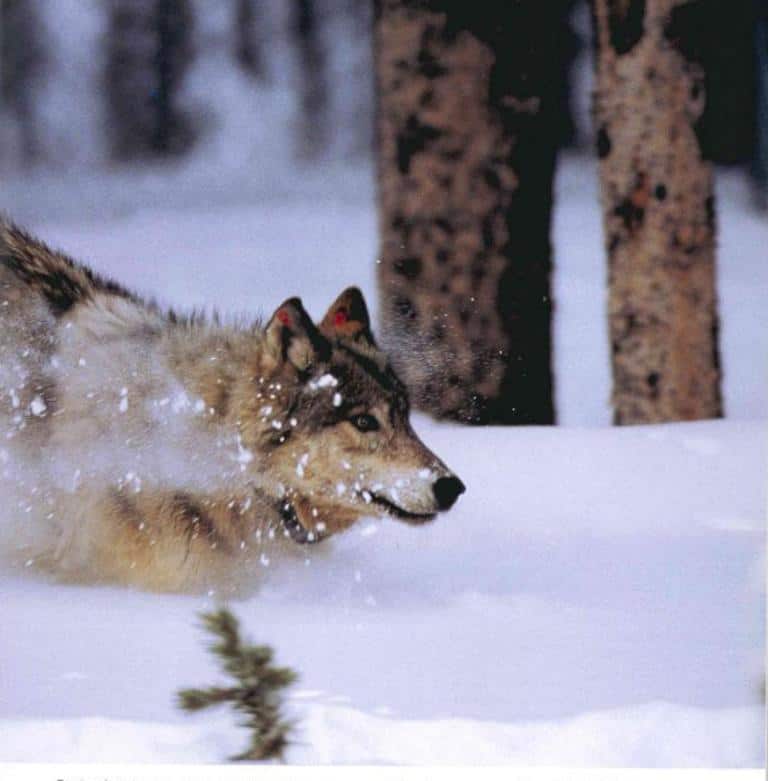Conservation Status
Listed as endangered under the ESA in 1976
Project Goals & Objectives
Our goal is to advance gray wolf restoration to the western Colorado portion of the Southern Rockies Ecoregion (SRE).
Project Background
Despite the improved conservation status of the gray wolf (Canis lupus) in the Great Lakes states (Minnesota, Michigan, and Wisconsin) and the northern Rocky Mountains (Montana, Wyoming, and Idaho), the task of recovering the species is not complete. No convincing argument concerning the conclusion of recovery efforts can be put forth until there has been a serious discussion about restoring the gray wolf to the SRE. This is due to widespread and persistent public support for the notion because of the sweeping recovery mandate of the Endangered Species Act (ESA) and the fact that no other region in the U.S. offers the same potential to support a population of wolves on a vast expanse of highly suitable public land that is currently unoccupied by the species.
The tremendous success with wolf restoration in the northern Rocky Mountains and Great Lake states underscores the practicality of accomplishing the same in the SRE. This notion is bolstered by recent studies that revealed tremendous potential for gray wolves to occupy the ecoregion in numbers and with a distribution that would satisfy the spirit and intent of both the federal and Colorado state endangered species acts.
The SRE represents the best remaining area for gray wolves in the US. The ecoregion stretches from north central Wyoming, through western Colorado, into north central New Mexico (See main image above). The ecoregion is defined by nearly 25 million acres of public land that supports unnaturally large populations of native prey. This amount of public land is twice as large as that available to wolves in the Yellowstone area and central Idaho, and five times as large as that available to Mexican wolves being reintroduced in the Southwest. This massive base of public land and robust populations of native ungulates support the claim that the ecoregion is a mother lode of opportunity for wolf restoration.
Two studies have estimated the carrying capacity of the SRE for wolves. The first study concluded that the Colorado portion of the area alone could support over 1,000 wolves. The second study concluded, after application of sophisticated modeling of variables of importance to wolf survival (e.g., distribution/abundance of native prey), that the SRE could support 2,000 wolves.
Fortunately, the public is broadly supportive of restoring wolves to the SRE (Figure 2). A public opinion poll conducted in 2001 revealed that 71% of Coloradoans supported wolf restoration. Majority support was widespread among various demographic groups.
The SRE is a vast refugia of high quality and highly secure habitat that is mostly located on public land managed for natural resources. Restoring the gray wolf in this area represents an outstanding opportunity to advance recovery of the species throughout a significant portion of its historical range, as mandated by the federal ESA.
From an ecological perspective restoring wolves to the SRE would provide nature with grist for recreating a wolf population that stretches from the arctic to Mexico. Nowhere else in the world does such a viable opportunity exist to achieve large carnivore conservation over such an extensive landscape. Noted wolf biologist Dr. L. D. Mech concluded the following when considering such an opportunity:
“Ultimately then this restoration could connect the entire North American wolf population from Minnesota, Wisconsin, and Michigan through Canada and Alaska, down the Rocky Mountains and into Mexico. It would be difficult to overestimate the biological and conservation value of this achievement.”
We have a rare opportunity to re-create the evolutionary potential of wolves, as well as reestablish the role of wolves as a keystone species with strong ecological interactions throughout the Rocky Mountain West. Evolutionary and ecological restoration will be hindered if we limit wolf recovery to the Northern Rocky Mountain and the Great Lakes states. Additional reintroductions in the SRE are imperative to return the gray wolf to its rightful place as an important and fascinating part of our nation’s ecological past and future.


